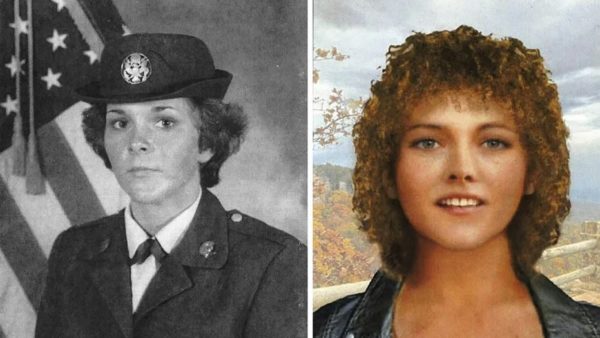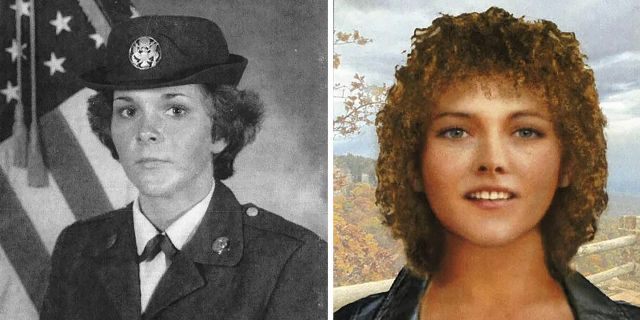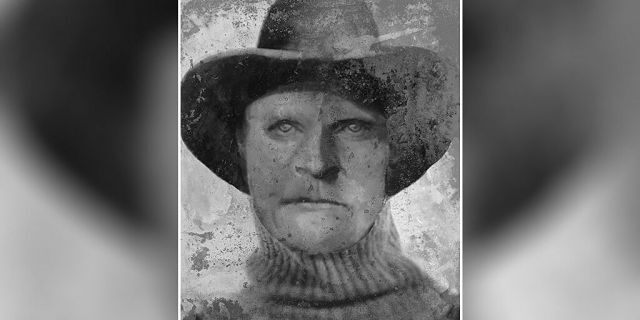
The same technique being used to catch cold case killers also is being used to identify unidentified cold case bodies.
DNA and genetic genealogy has been transforming the way cold case murders are solved since its introduction in 2018.
It also has transformed the way skeletal remains are identified in cases that have stumped investigators for decades.
The nonprofit DNA Doe Project is focused solely on these types of cases and in the past 22 months their genealogist volunteers have named about two dozen John and Jane Doe victims. Recently, the list has grown with each passing week.
Here are some of their successes:
LIME LADY
Tamara Lee Tigard’s body was found in April 1980 on the banks of a river near Oklahoma City. She was shot to death. Her identification was announced Jan. 30 of this year.

This undated military photo and artist rendering by the DNA Doe Project provided by the Oklahoma County, Okla., Sheriff’s Office shows Tamara Lee Tigard. (Oklahoma County Sheriff’s Office via AP)
She was discovered on her 21st birthday and was known as the “Lime Lady” because her body was covered in lime, in a possible attempt to destroy it.
DNA, GENETIC GENEALOGY HELPING TO SOLVE THE COLDEST OF COLD CASES
Investigators determined she served in the Army and her military dental records helped confirm her identity.
“Now the work starts to try to determine if there are any suspects who might be the actual murderer,” said Mark Myers a spokesman for the Oklahoma County Sheriff’s Office.
CORONA GIRL
Sue Ann Huskey was 17 when her body was found in Jarrell, Texas, in September 1989. Her identification was announced last month on Jan. 15.
She had on a Corona beet T-shirt, thus the name “Corona Girl.”
Huskey was identified by the DNA Doe Project through her grandparents’ DNA.
“They have given [us] our sister back and now we can take her home,” Huskey’s sister Amanda Cantrell said, according to KXAN-TV.

Remains found near a Michigan interstate in 1988 were identified as those of a missing Oklahoma woman, 28-year-old Marcia Bateman. (Michigan State Police)
I-196 JANE
Marcia Bateman’s body was found in October 1988 in Van Buren County, Mich., two months after she was reported missing in Oklahoma City, where she lived. Her identification was announced Nov. 25, 2019.
Her body was found near Interstate 196, thus the name “I-196 Jane.” Michigan State Police said she was 28 and had been associated with prostitution and drugs before her death, which they said was suspicious.
DNA HELPS IDENTITY 2 WOMEN FOUND DEAD IN TEXAS ‘KILLING FIELDS’ DECADES AGO
Bateman’s mother died never knowing what happened to her daughter.
“As an investigator, I can tell you that there are a lot of things that can happen to you, but not knowing what happened to a loved one is probably the worst,” Detective Sgt. Scott Ernestes said.

This undated composite sketch provided by Anthony Redgrave, courtesy of Lee Bingham Redgrave, shows Joseph Henry Loveless. (Anthony Redgrave/Courtesy of Lee Bingham Redgrave via AP)
IDAHO CAVE
Outlaw and bootlegger Joseph Henry Loveless’ bones were found in an Idaho cave on two separate dates, in 1979 and 1991. His head was never found. His identification was announced Dec. 31, 2019.
MURDERED 20-YEAR-OLD WOMAN FINALLY IDENTIFIED 31 YEARS LATER
Loveless was last seen in 1916 breaking out of a jail where he was being held in the murder of his wife.
His identification is believed to be the oldest using DNA and genetic genealogy.
BELLE IN THE WELL
Louise Flesher’s body was found in a well in Lawrence County, Ohio, in April 1981, thus the name “Belle in the Well.” She had been strangled. Her identification was announced July 29, 2019.
She had been born in 1915 and may have been killed two years before her body was found, the Huntington Herald Dispatch reported.
A key for a Greyhound Bus terminal locker, a bus ticket, a pay stub and a Jerry Falwell commemorative coin were found on the body.
“I was just totally blown away, because I never looked at genealogy as helping solve a cold case,” Paula Solar, a distant relative of Flesher’s said, according to the paper.
BUCKSKIN GIRL
The body of 21-year-old Marcia King was found in Miami County in Ohio in April 1981. She was wearing jeans and a buckskin jacket with a Native American design, thus the name “Buckskin Girl.” She had been strangled. Her identification was announced April 11, 2018.

Marcia King, 21, was known as “Buckskin Girl” before her body could be identified using DNA and genetic genealogy. (Miami County Sheriff’s Office)
King was from Arkansas and it’s not clear how she wound up in Ohio, but she had lived a transient life before she was killed.
CLICK HERE TO GET THE FOX NEWS APP
After the announcement, Miami County Chief Deputy Sheriff Steve Lord told the Dayton Daily News that King’s mother wanted to replace her daughter’s “Jane Doe” headstone.














